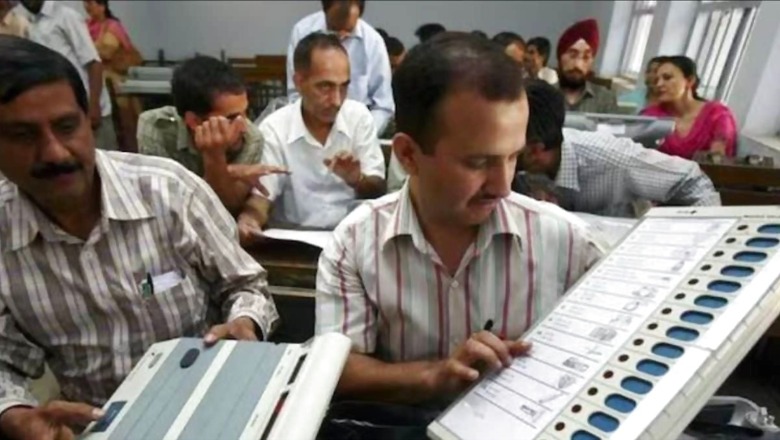
views
The Election Commission of India on Tuesday issued a technical standard operating procedure (SOP) for burnt memory checking and verification (C&V) of electronic voting machines (EVMs), offering more choices to poll candidates.
Candidates who will apply for checking or verification of burnt memory or microcontroller of EVMs can choose machines from any polling station in an assembly constituency or segment and can mix and match BU-CU-VVPAT from any polling station in an assembly constituency for verification, the poll body said. An EVM consists of a ballot unit (BU), a control unit (CU), and a verifiable paper audit trail (VVPAT).
The candidates will also be empowered to select the sequence of connection of EVM units, and the number and sequencing of votes cast in the mock polls.
The order was issued after candidates moved the Supreme Court to check for tampering in the machines in the recent Lok Sabha polls.
Focus on outcome-based processes
According to the ECI, the SOP was designed with a focus on outcome-based processes. It allows candidates to make selections from multiple choices, by giving a vast number of random test vectors as inputs for evaluation of intended outcomes. The poll body has adopted the choice-based approach with the active participation of candidates, instead of a “controlled environment C&V process”.
“The ‘randomness’ and ‘enormity’ of test vectors and expanded choice-based approach instead of controlled environment C&V process of burnt memory eliminates possibility or apprehension of any bias or hidden functionality in the firmware, by showing intended outcome(s) under parameters selected by the candidate and at every stage of C&V process,” the poll body said in a statement.
The eligible candidates can select EVMs from any polling stations of the constituency, assembly or Lok Sabha, subject to a maximum of five per cent EVMs used in that assembly constituency or segment to undergo the C&V process.
This, the ECI said, will ensure that the EVMs are picked up, from across the constituency, as per the choice of the applicant without the involvement of a third party or officials in selecting or leaving out any particular machine.
Candidates can ‘mix and match’
Further, the choice to mix and match EVM units from any polling station in the assembly constituency is also given to the candidates.
“If any applicant candidate selects any specific unit(s) (BU or CU or VVPAT) of a particular polling station, he/she is not bound to choose other units of the same set used at that polling station. Instead, the applicant candidate can mix and match and give his choice of other unit(s) from remaining polled units used at other polling station(s) in the assembly constituency or assembly segment to make a set i.e. a combination of BU(s), CU and VVPAT,” the ECI added in its statement.
The choice of connecting BUs, CUs, and VVPATs in any sequence has also been offered in the SOP. That means the applicant candidate can choose to connect BUs, CUs, and VVPATs in any sequence as desired.
Self-diagnosis
The SOP also lists that self-diagnosis by EVM units will also be done. All units will undergo self-diagnosis on “switching on”. Several electrical parameters will be checked including the fidelity of the burnt memory and only self-diagnosed units will thereafter go for further C&V.
Further, mutual authentication by EVM units will also be done for the machines, selected by candidates after mix and match. Successful mutual authentication takes place only between genuine EVM units and the result of the self-diagnosis of connected units is displayed on CU. The mutual authentication process ensures that spurious or unauthorised units do not get connected with ECI-EVMs at any stage and thus burnt memory of all units undergoes C&V.
Mock polls
In the SOP, the poll body has also allowed the candidates to choose the number and sequence of mock polls where candidates can pick any sequence or pattern to cast any number of votes subject to the maximum limit of 1,400 votes.
“This latitude of choices ensures creation of a very large number of inputs to the EVMs by way of a combination of number of key presses and the sequence in which the keys are pressed,” the ECI said.
Citing an example, the poll body said that applicant candidates can cast any number of votes to any particular BU key of their choice, say 25 votes to key number 1, 15 votes to key number 2, 7 votes to key number 3, and so on.
Also, the applicant candidates can cast votes to the various key buttons on the BUs in any sequence or pattern of their choice – they may choose to cast votes to key numbers 2, 4, 6, 8…or to key numbers 1, 7, 5, 9, 3, 6…or they may choose to cast all votes to any single key number.
“The CU records a vote only for the key button pressed on the BU(s) irrespective of the sequences or combinations in which they are pressed,” the ECI added.
For the mock VVPAT slips count, the ECI said that the counting would be done as per the procedure prescribed by the commission.
“C&V table to be used for counting of mock VVPAT slips shall be converted into VVPAT Counting Booth (VCB) to avoid misplacement of mock poll VVPAT slips due to large numbers,” it said.
CCTV monitoring and videography
Further, the complete checking and verification process will be held under CCTV monitoring and videography. The C&V process is to be conducted from 10 am to 7 pm and preferably be completed in a single calendar day on a set of EVMs.
“However, in case Checking and Verification activity is not completed by 7 PM and the test voting process is continuing, in such cases, the C&V activity shall not be stopped in between and test voting may be continued till 11:55 PM. Counting of votes from the CUs and VVPAT slips count can be conducted on the next day, if so desired by the applicant,” it added.
On June 1, the poll body issued a detailed administrative SOP for the application process, protocols for units to be checked, safeguards and controls for the conduct of the checking/verification process, and required documentation.
The ECI received eight applications for the Lok Sabha and three for assembly elections for checking/verification of burnt memory/microcontroller of EVMs after the announcement of results.


















Comments
0 comment